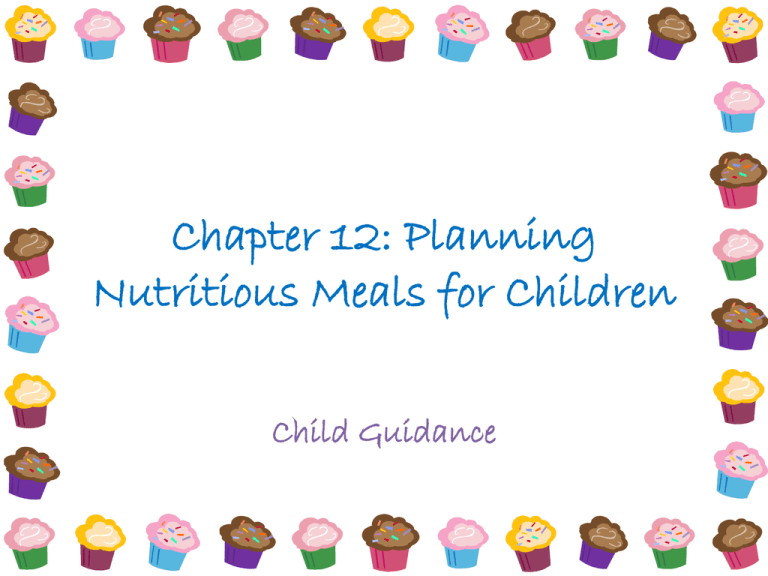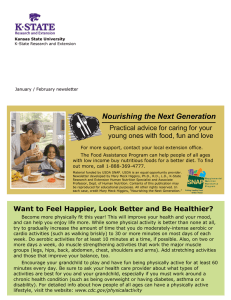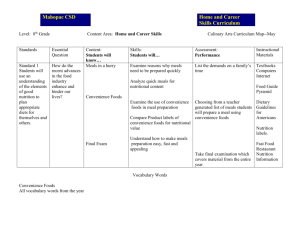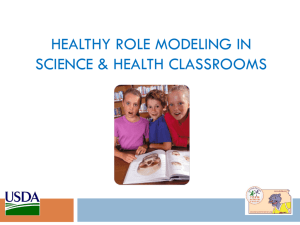Chapter 12: Planning Nutritious Meals for Children
advertisement

Chapter 12: Planning Nutritious Meals for Children Child Guidance Fast Food Facts • With a partner, look up a fast food restaurants nutritional information. Then read & Review the nutritional information from popular restaurants. • Make a list of the top 10 worst foods (highest calories) • And the top 5 healthiest (lowest calories) Warm-up • Read the article on picky eating! • What are some tips for parents/caregivers to get children to eat? • Do you remember being a picky eater? • What foods did you refuse to eat? Nutrition • Nutrition= the science of food and how the body uses the foods taken in. • Nutrients= chemical substances in food that help build and maintain the body. • There are six groups of nutrients needed for growth and maintenance. • They are protein, carbohydrates, fats, vitamins, minerals, and water. • Nutrition tips from Michelle Obama • Teaching nutrition concepts requires a good nutrition program. • A good program centers on the needs of children, including their ethnic backgrounds. • Program goals should include: – Providing nutritious meals and snacks – Introducing new healthy foods – Encouraging healthy eating habits – Involving children in meal activities – Providing nutrition information to parents • Food also provides energy. The value of food is measured in calories. • Children need more energy than adults, in relation to body weight. • A very active 4 year old boy weighing 42 lbs needs about 1600 calories per day. • A somewhat active 45 year old man weighing 160 lbs needs about 2600 calories per day. • The child needs about 38 calories per pound while the man needs 16 calories per pound. • Children’s growth is greater and they are also more active, thus they use a great deal of energy. Assignment 2/18/15 • Write all vocabulary words and the definition from the book . • Read through page 225 Nutritional Problems • The effects of poor nutrition on cognitive abilities have been proven in several studies. • Under nutrition= not eating enough food to keep a healthful body weight and activity level. • Malnutrition= a lack of proper nutrients in the diet, happens when a nutrient is absent or lacking. Signs may be irritability, bowed legs, sunken eyes, decaying teeth, fatigue. Nutritional Problems • Overeating= the intake of more food than needed, can cause health and emotional problems. • Obesity can lead to health problems such as high blood pressure, diabetes, heart disease, etc. • Many obese children lack self esteem. • Diabetes= a condition in which the body cannot properly control the level of sugar in the blood. • Epidemic MyPyramid • A set of online tools developed by the USDA. • A special version is designed specifically for children. • My Plate Old vs. new MyPyramid • What does the My Pyramid recommend for active children ages: – 2-3 – 4-8 Dairy – Children need at least 2 cups of milk products daily. – Children ages 2 years and younger need the fat that whole milk contains. For children over 2, low fat or fat free milk is better. Grains – A child’s diet should include 6 servings of grain daily. – Choose whole grain products! Meat & Beans – Protein is the most important nutrient supplied by this group. – Beef, pork, veal , lamb, eggs, seafood, and poultry provide the highest quality of protein. – Dried beans, peas, lentils, nuts and seeds are also in this group. Vegetables – Children should get 2 ½ cups of vegetables daily. – Vegetables should be served raw if children are able to chew and swallow them without choking. – Otherwise, cook them as little as possible since cooking veggies in water can lower the vitamin content. Fruit – Serve fruits raw, slightly cooked, or in the form of 100% juice. – Rich sources of vitamin C include citrus fruits such as lemons, limes, oranges, and grapefruits. – Babies eating lemons Oils – Oils are found in nourishing foods like fish, peanut butter, olives, and avocados. – Limit fats and oils to the ones that provide good health! – Oil is rich in calories, especially those in solid form. Choose evoo! What is EVOO? Meeting Special Nutrition Needs • As a teacher, one of your tasks is helping each child meet his or her nutritional needs. • Children with diabetes do not produce insulin, the hormone that regulates blood sugar level. • Managing the planning and scheduling of snacks and meals can be a challenge. • Special nutrition needs may also exist among children with allergies. • An allergy is the body’s negative reaction to a particular substance. • The offending substance is called an allergen…such as pollen, dust, mold, or food. • The most severe allergic reaction is anaphylactic shock, which could be fatal. • Offer a safe substitute and monitor food brought into classroom. • Food allergies in school Planning Meals • Children will eat more if the food appeals to them. • Variety- introduce new foods with familiar ones. • Texture- Serve one soft, one crispy and one chewy food each meal. • Flavor- children prefer mildly seasoned foods. • Color- use colorful foods, add food coloring to applesauce or pudding! • Form- serve foods in bite sized pieces. Soup may be difficult. • Temperature-Variety in temperature, cold milk with cookies! • Portion sizes Multicultural Experiences • Children should be exposed to healthful foods from different cultures. • Including foods from the child’s culture will help promote cultural identity and self esteem. • Share recipes with family members! • Invite parents to prepare meals for class. Our Multicultural Experience • Culture specific - Bring a dish enough for everyone to sample. It can be something special from your culture/family • Bring a copy of the recipe to share with the class Breakfast • The purpose of breakfast is to break the 1014 hour overnight fast. • Breakfast provides energy for morning activities! • Self-serve breakfast are popular in child care centers. This includes dry cereal, yogurt, muffins, juice and milk. Lunch • Minimum recommendations for lunch: – 1 milk – 2 fruits, vegetables, 100% juice, or any combination. – 1 grain source, such as bread, cereal, or noodles. – 1 meat or alternate, such as poultry, fish, soy, cheese, egg, or dry beans. Snacks • Provide snacks between meals to help satisfy hunger. • Most programs offer a mid morning and mid afternoon snack. • Schedule snacks at least 1 ½ hour before meals. • Avoid junk food. Simple snacks are best like cheese and crackers! Safe Foods • Children may eat quickly which can cause them to choke. • Avoid foods like cherries, candies, marshmallows, nuts, peanut butter, raisins, popcorn, raw celery, raw carrots, grapes and hotdogs.




